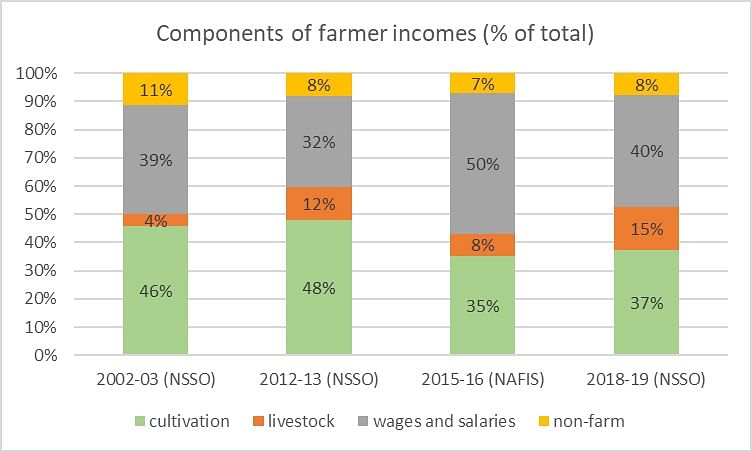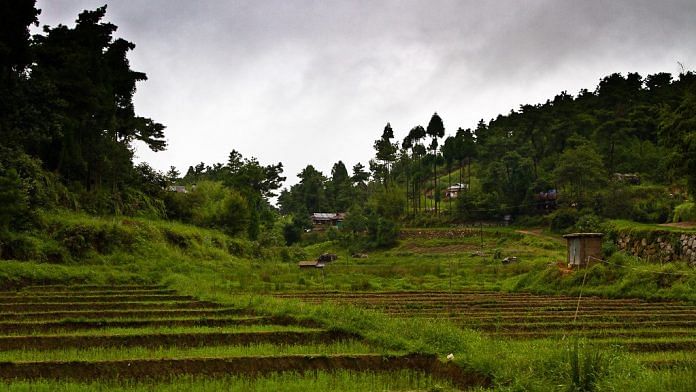Not Punjab farmers, but those from the northeastern state of Meghalaya are now the richest in India. This is according to the government of India’s recently released survey report titled ‘Situation Assessment of Agricultural Households and Land and Holdings of Households in Rural India, 2019’. As per this report, in 2018-19, an average farmer household in Meghalaya earned about Rs 29,348 per month whereas a Punjab farmer’s household earned about Rs 26,701 (Figure 1).
Figure 1: State-wise monthly farmers’ income 2018-19

Jharkhand, Odisha, West Bengal, Bihar, and Uttar Pradesh recorded the lowest farmer incomes. In fact, the sum total of incomes earned by farmers in the four states of Jharkhand, Odisha, West Bengal, and Bihar is lower than the income of a Meghalaya or a Punjab farmer.
In a series of articles to follow, we intend to decode this survey data in detail. In this brief article, I track basic trends in farmer incomes for major agricultural states. But first a little context of the data itself.
Data on farmer incomes
Just as India does not have an official estimate of the number of farmers in the country, there is no annual estimate available of the level of incomes earned by them. This number is estimated by National Statistical Office (NSO) via farmer surveys usually done every 10 years. As on today, the most recent farmer income estimates from NSO are available for three years: 2002-03, 2012-13 and the recently released 2018-19.
Apart from this, there is one more estimate on farmer incomes from NABARD, which undertook its Nabard All India Rural Financial Inclusion Survey (NAFIS) in 2016-17. This survey gave levels of farmer incomes for 2015-16. There is, however, one point of caution when comparing farmer income data of NSO with NAFIS. Unlike NSO, NAFIS uses a much wider definition of rural areas, which is likely to create an upward bias in the estimates. In other words, if NAFIS would have followed the same definition as NSO, the estimates of farmer incomes in NAFIS may have been lower than what were reported. Nevertheless, we compare the trends in farmer incomes across the four time-periods.
Also read: NSS survey on farmers is a mid-term report card of Modi’s promise, with ‘fail’ written over it
Indian averages
As per NSO, an average Indian farmer family earned about Rs 10,218 per month in 2018-19. This value was Rs 6,427 in 2012-13 and Rs 2,115 in 2002-03. In nominal terms, this translates to an average annual growth rate of about 10.3% between 2002-03 and 2018-19, and about 8% between 2012-13 and 2018-19 (Figure 2).
Figure 2: Trends in all-India incomes

In real terms (base 2015-16), the incomes grew from about Rs 5,541 in 2002-03 to Rs 7,863 in 2012-13 to now about Rs 9,406. This translates to an average annual growth rate of about 3.4% between 2002-03 and 2018-19 and about 3% between 2012-13 and 2018-19 (Figure 2).
Income from cultivation is only one source of earning for a farmer household. As per both NSO and NAFIS, there are four main sources of farmer incomes: (i) cultivation activities, (ii) rearing of livestock and related activities, (iii) wages and salaries earned by working under schemes like MGNREGA, or on others’ farms or any other job; and (iv) non-farm activities (Figure 3).
Figure 3: Trends in All-India composition of farmer incomes

Note: For 2018-19, the income from leasing-out land is added in ‘non-farm’ income

Note: For 2018-19, the income from leasing-out land is added in ‘non-farm’ income
According to Figure 3, it appears that in 2018-19, a farmer earned about Rs 3,800 from cultivation, more than Rs 4,000 from working as labourer or worker, about Rs 1,580 from undertaking livestock activities and remaining about Rs 775 from non-farm activities.
Comparing data between years, two trends appear, inter alia,
- Farmers are earning more from activities other than cultivation. In 2018-19, about 55% of the farmer household’s incomes came from livestock activities and wages and salaries. This contribution was much lower at about 43% in 2002-03 and 44% in 2012-13;
- In real terms, income from cultivation appears to have fallen for an average farming household between 2012-13 and 2018-19. In 2012-13, a farmer household earned about Rs 3,769 per month from cultivation but in 2018-19, the income from cultivation fell to Rs 3,496 per month.
Also Read: Don’t get caught up in MSP battle. India must move to end inequality in WTO laws
State-wise trends in farmer incomes
Among the main agricultural states, it appears that in the 16 years between 2002-03 and 2018-19, Rajasthan has had the fastest nominal income growth rate (14.2%) and Jharkhand the slowest (5.5%).
Figure 4: State-wise trends in farmer incomes (selected agricultural states)

However, between 2012-13 and 2018-19, Bihar (13.3%) and Uttarakhand (19.3%) emerge to have witnessed the fastest growth rates and Odisha (0.5%) and Jharkhand (0.6%) the slowest.
Odisha is an interesting case. Between 2002-03 and 2012-13, farmer incomes grew the fastest in the country in Odisha at a compound annual growth rate (CAGR) of about 16.7%, but since then the growth rates seem to have shrunk to become the lowest in the country at 0.5% (between 2012-13 and 2018-19).
Conclusion
From a preliminary analysis of the 2018-19 NSO data, it appears that farmer incomes have grown much slower than anticipated. In February 2016, Prime Minister Narendra Modi vowed to double the income of farmers by 2022-23. As per the Dalwai Committee report, this doubling of income required the real farmer incomes to grow at a CAGR of about 10.4% in real terms between 2015-16 and 2022-21.
However, between 2015-16 and 2018-19, if one compared the NAFIS farmer income estimate with NSO’s, it appears that the farmer incomes grew only at a CAGR of about 1.7% in real terms. If farmer incomes have still to double by 2022-23, then the required growth rate has to be much more than 13-14% per year from 2018-19 until 2022-23.
Shweta Saini is a Senior Fellow (Visiting) at ICRIER, New Delhi. She tweets @shwetasaini22. Views are personal.
(Edited by Prashant)



